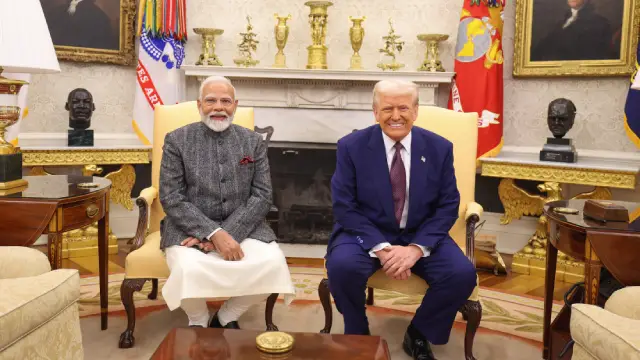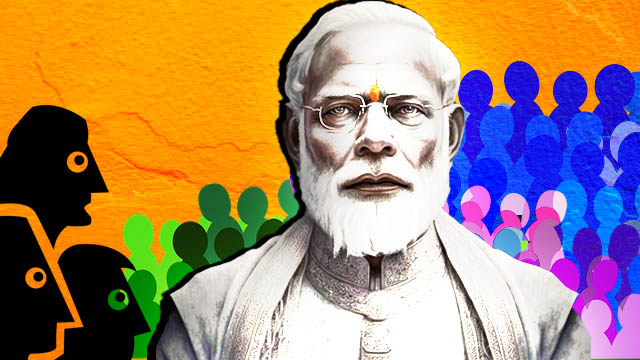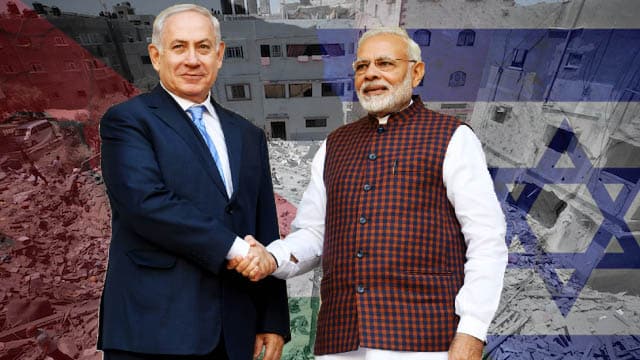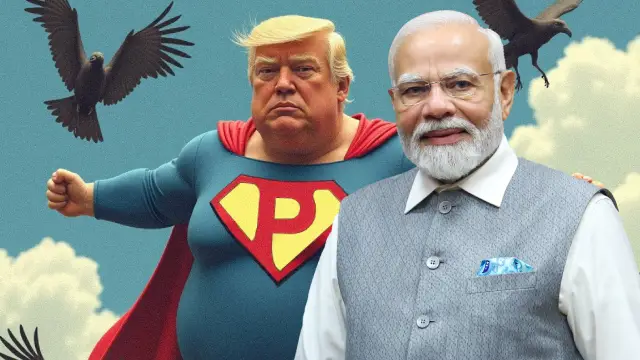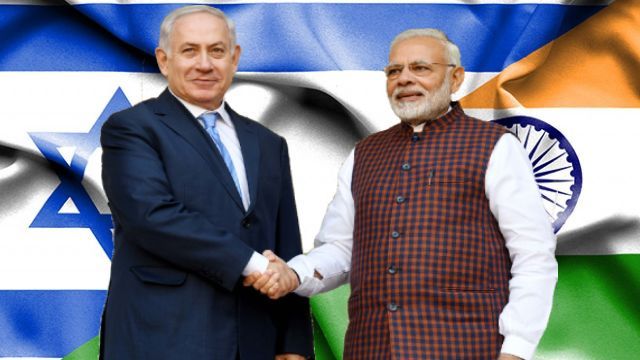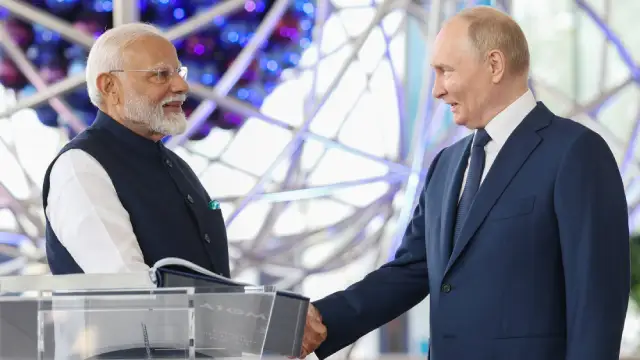Indian Prime Minister Narendra Modi’s meeting with American President Donald Trump during his February 12th-13th US tour has been portrayed as successful by his government. The promise of increasing the Indo-US bilateral trade to $500bn by 2030 has been lauded by Indian diplomats and Mr Modi’s followers. What India has remained mum on is that Mr Modi’s meeting with Mr Trump has turned the Indo-US bilateral trade relations in favour of Washington DC, dealing a significant blow to New Delhi’s interests.
Friday, February 14th, India’s Bombay Stock Exchange’s (BSE) Sensex fell to 75,939.21, a -199 point or 0.26% drop, at the end of the day when the news of Mr Modi’s meeting with Mr Trump flooded India’s news channels.
The biggest stock market, the National Stock Exchange (NSE) closed at 22,929.25, a 0.44% fall of 102.15 points.
The scenario at BSE and NSE showed the markets didn’t reflect the celebration visible on mainstream media outlets. Why? Did the stock markets read the situation wrong?
In a nutshell, while Mr Modi’s meeting with Mr Trump was a desperate attempt by the former to enter the good book of the latter, India didn’t gain anything substantial, except for the extradition of a terrorist accused of the 2008 terror attack in Mumbai, a few hugs exchanged between the Indian prime minister and the US president, and some words of praise.
What did India lose?
Before Mr Modi’s meeting with Mr Trump, the latter has made it clear that his second innings will focus on intensifying his protectionist agenda and securing American interests in bilateral trades.
What Mr Trump acknowledges is that while the US is bound to have trade deficits if it deals with countries like China, which are far ahead of it in manufacturing capabilities, Washington can flex its muscle and budge the weaker countries to accept its demand for greater market access.
By agreeing to the US’s demands, Mr Modi has jeopardised the interests of Indian industries, his critics, including the leaders of the Indian National Congress (INC) and the left parties, believe.
For India, the US has been one of the few countries with which it has enjoyed a massive trade surplus and it helped several industries, including the service industry to thrive.
However, using his threat of reciprocal tariffs, Mr Trump has undone the favourable conditions that India has hitherto enjoyed.
The defence tragedy
During Mr Modi’s meeting with Mr Trump, India has been forced to buy American military hardware, including an option for fifth-generation F-35 fighter jets in the future, to close the trade deficit at the US’s end.
The American proposal includes C‑130J Super Hercules, C‑17 Globemaster III, P‑8I Poseidon aircraft; helicopters like CH‑47F Chinooks, MH‑60R Seahawks, and AH‑64E Apaches; Harpoon anti-ship missiles; M777 howitzers; and MQ‑9B drones.
India has agreed on new procurements and co-production arrangements for Javelin anti-tank guided missiles and Stryker infantry combat vehicles in India. India also has a plan to procure six additional P-8I maritime patrol aircraft for maritime surveillance in the Indian Ocean Region.
Lockheed & Martin, the company that manufactures the F-35 jets, has declared that any discussion on the sale of the fighter jets depends on government-to-government negotiations. Following such discussions, the Pentagon brokers a deal between the US military-industrial complex and the buyer government.
Now, in his bid to appease Mr Trump, Mr Modi nodded to his demands and made a major gaffe.
India’s defence deals are not done according to the whims and fancies of prime ministers but according to real-time requirements and through a proper tendering and expert assessment process. However, by nodding to the US military hardware purchase, especially F-35 jets, Mr Modi has signalled an overriding of the standard procedure, indicating India’s lack of courage.
Though Foreign Secretary Vikram Misri has downplayed the gaffe, emphasising that India will take the tender route before making any decision on purchasing F-35 jets, it seems that the Ministry of Defence (MoD) will not defy Mr Modi.
In that case, India will be forced to buy the F-35 jets, which have become obsolete with China’s unveiling of its sixth-generation J-36 jets.
Moreover, even if such a deal goes through all the checks and balances, closing a major fighter jet purchase deal can take years, and it will not benefit India, as it will end up owning outdated technology when the world moves towards sixth and seventh-generation fighters or shift totally to drone-based military aviation doctrine, which Elon Musk, the American tycoon close to Mr Trump, has been advocating as a next-generation idea to the Pentagon.
In a nutshell, the US-India defence deal agreed during Mr Modi’s meeting with Mr Trump risks saddling New Delhi with long‐term constraints.
While the pact agreed upon by Mr Modi deepens India’s military ties with the US and promises state-of-the-art systems, India finds itself locked into a cycle of expensive purchases rather than genuine technological empowerment.
The proposed technology transfers, for example, restrict domestic manufacturing and limit export potential, thus curtailing India’s ability to build a self-reliant defence industry. This defeats Mr Modi’s ‘Make in India’ vision as it will curtail the scope of India’s indigenous innovation and keep it tied to obsolete American military hardware manufacturing for domestic consumption only.
Russia’s special military operations in Ukraine have brought under scrutiny the operational efficacy of US weapons. Lessons from the Ukrainian conflict suggest that high-profile systems may not always perform as expected on the battlefield, especially in the era of unconventional and cyber warfare.
Moreover, while Mr Modi boasts of his nationalist credentials and equated himself with Mr Trump during their joint press conference, he agreed to turn India into a junior partner of the US in its military expeditions in the “Indo-Pacific” war theatre, to challenge China.
This poses a significant challenge to regional peace and stability, which can be bad for India’s image as a growing economy in the region.
The trade and commerce issue
The “Mission 500” initiative sets an ambitious target of more than doubling India-US bilateral trade to $500bn by 2030. While this figure appears impressive on paper, it masks underlying concessions that could erode India’s longstanding trade surplus with the US.
To kick-start this push, the agreement commits India to lowering tariffs on a range of US products—including bourbon, motorcycles, ICT products, and metals—while also enhancing market access for US agricultural goods such as alfalfa hay, duck meat, and medical devices. In contrast, while American consumers have opened up to Indian mangoes and pomegranates, the broader terms of trade liberalisation appear to be more beneficial to Mr Trump’s agenda of promoting American exports.
Moreover, the deal envisages the negotiation of a multi-sector Bilateral Trade Agreement by the fall of 2025, aimed at reducing both tariff and non-tariff barriers.
This integrated approach to market access, coupled with the promise of deeper supply chain integration, could further tilt the balance in favour of US industrial goods, putting additional pressure on India’s domestic sectors, which have been reeling under crisis since the financial year 2017-18.
Additionally, the agreement between the two sides highlights significant Indian greenfield investments in the US, totalling approximately $7.35bn in sectors such as aluminium goods, steel manufacturing, battery materials, and pharmaceuticals.
While these investments support over 3,000 high-quality jobs in America, they do little to counterbalance the potential influx of US imports that could disrupt India’s domestic industries and worsen its trade deficit and unemployment scenario.
Despite the rhetoric of shared prosperity and innovation, the numerical targets and concessions embedded in the trade deal point to a scenario where India may be trading away its commercial advantage.
The liberalisation measures, when coupled with the pressure to meet the lofty $500bn trade goal, risk shifting the economic equilibrium in favour of the US, bringing forth a classical neo-colonial setup.
Losing power to energy
The energy security segment of the pact, ostensibly designed to bolster India’s economic growth and stabilise energy markets, conceals provisions that could leave India disproportionately exposed.
In committing to the US-India 123 Civil Nuclear Agreement, the deal envisions the construction of large US-designed reactors and advanced small modular reactors in India, yet the accompanying amendments to India’s Atomic Energy Act and the Civil Liability for Nuclear Damage Act (CLNDA) effectively shift the burden of compensation onto New Delhi.
This realignment of liability—echoing the corporate impunity witnessed in the aftermath of the 1984 Bhopal disaster—raises serious concerns about India’s ability to safeguard its citizens in the event of a nuclear catastrophe. Despite his nationalistic rhetoric, Mr Modi has turned India into an appendage of the US’s neo-colonial ambitions, the left parties allege.
Advanced economies have largely circumscribed their reliance on nuclear power precisely because of such risks, making India’s calculated leap into a similar model all the more precarious.
Moreover, while the agreement champions enhanced collaboration in the oil, gas, and nuclear sectors, the strategic framework is skewed towards making the US the pre-eminent supplier of crude oil, petroleum products, and liquefied natural gas.
This will have a negative impact on India’s ties with Russia, as the latter has been providing India’s refineries with cheap oil to circumvent the western sanctions. India has to cut Russian imports due to prevalent sanctions and shell out more money for US fuel imports, which will impact its foreign reserves.
The entire energy deal signed during Mr Modi’s meeting with Mr Trump cements an arrangement where US firms, cushioned by a reduced liability regime, are less accountable for potential disasters and more prone to accumulating profits.
High-tech deals favour US
The technology and innovation segment of the pact is couched in grand ambitions—from the launch of the US-India “Transforming the Relationship Utilizing Strategic Technology” (TRUST) initiative to the promise of INDUS Innovation and INDUS-X—but it risks entangling India in a framework that prioritises American technological paradigms over indigenous growth, which will hamper India’s own growth ambitions in the technological space.
While the initiative spans vital sectors such as defence, artificial intelligence (AI), semiconductors, quantum technologies, and space, its central pillar—the roadmap for accelerating AI infrastructure—lays the groundwork for large-scale US-origin projects on Indian soil.
This not only funnels critical know-how through American channels but also threatens to curtail New Delhi’s capacity to nurture its own digital ecosystem, especially when it aims at replacing China in the technology and innovation space.
Moreover, commitments to build ‘trusted’ supply chains for semiconductors, critical minerals, and advanced materials are shadowed by stringent export controls and technology security measures, which may leave India beholden to US regulatory standards.
Joint ventures in civil space cooperation, including the planned NASA-ISRO mission and the pioneering NISAR project, further underscore an imbalance: while the narrative celebrates mutual leadership, the mechanisms in place risk positioning India as a junior partner in a high-stakes technological race.
In effect, the deal’s promise of enhanced industry and academic partnerships is undermined by a structural reliance on American investments and technology, potentially stifling India’s strategic autonomy and long-term innovation potential.
Into the US-led orbit
In 2022 and 2023, Mr Modi’s government has emphasised its intention to be a part of the rising multi-polar world order and increased its engagement with bodies like BRICS and Shanghai Cooperation Organization (SCO). In reality, Mr Modi didn’t want to increase his dealings with the China-Russia axis, fearing that could alienate the West. Rather, he has used India’s membership in the multipolar bodies to bargain with the US-led collective West.
The multilateral cooperation strand of the pact finalised during Mr Modi’s meeting with Mr Trump lays bare how India is being steered into a US-led orbit at the expense of its longstanding multipolar ambitions. The agreement’s preamble positions a “free, open, peaceful and prosperous Indo-Pacific” as the linchpin of US–India ties, with explicit references to ASEAN centrality and the lawful use of the seas.
Yet this rhetoric conceals a strategic pivot—by anchoring itself to the Quad and other US-backed initiatives, India risks being relegated to a junior partner—thereby distancing itself from alternative platforms such as BRICS and the SCO, which have traditionally offered a more balanced global order.
Moreover, through these platforms, India exhibits its intention to carry out confrontation with its neighbour China more than its intention to collaborate with it for shared prosperity.
The deal is replete with concrete commitments that underscore this realignment. For instance, Mr Modi is set to host Mr Trump for a Quad leaders’ summit, while new initiatives—such as enhanced airlift capacity, maritime patrols, and the Indian Ocean Strategic Venture—promise to tighten bilateral integration, at the cost of India’s subservience.
Notably, a multi-billion, multi-year investment in an undersea cable project, spanning 50,000 km and connecting five continents, exemplifies the scale of US influence creeping into India’s strategic infrastructure. Additionally, the pact envisages further plurilateral anchor partnerships across the Western Indian Ocean, Middle East, and Indo-Pacific, with fresh initiatives expected by fall 2025.
Special emphasis has been laid on the India-Middle East-Economic Corridor (IMEC) that the US wants to build as an alternative to China’s ambitious Belt-Road Initiative (BRI). The IMEC has hit a roadblock since Benjamin Netanyahu launched his genocidal war against the Palestinian people in Gaza. However, India and the US are still pushing for the deal that they see as a game changer.
In real terms, these developments signal a deliberate shift towards a US-centric framework that not only sidelines India’s participation in truly multipolar platforms but also risks compromising its strategic autonomy. The emphasis on joint military operations—illustrated by India’s anticipated leadership role in the Combined Maritime Forces—and concerted efforts against terrorism further align New Delhi with Washington’s global agenda, especially to counter China and fight the Yemeni Houthi rebels who have disrupted marine traffic in the Red Sea to push Israel towards a ceasefire.
Will Modi’s meeting with Trump help India?
Mr Modi’s meeting with Mr Trump didn’t bring anything promising for India, except a few praises for the prime minister. The Indian industry, which has been facing a low demand in the domestic market, didn’t get any export opportunities or fresh promises of heavy investments to expand and create jobs for the country’s growing unemployed population.
India’s merchandise export between January and December 2024 was expected to be $441.5bn, with a growth of 2.34% year-on-year (y-o-y) from $431.4bn in 2023. On the other hand, the service sector’s exports have seen a growth of 10.31% to $372.3bn from $337.5bn in 2023.
This shows that India still heavily relies on the service sector rather than manufacturing. Moreover, in 2024, the contribution of labour-intensive industries has also seen a significant drop compared to data from 20 years ago.
For example, textile and garments export contribution fell from 21.1% in 2004 to 8% in 2024, and jewellery export contribution fell from 16.9% in 2004 to 7.5% in 2024.
With a trade-deficit-driven relationship cemented during Mr Modi’s meeting with Mr Trump, it’s unlikely that the industries will enjoy significant growth at the crucial stage of India’s manufacturing drive and it will have ripple effects on the economy.
It’s unlikely that Mr Modi’s meeting with Mr Trump has taken place without the Indian side considering these aspects. However, the reluctance to act like free countries and demand equal treatment from the US exhibited India’s lack of confidence to face challenges in the changing circumstances, something the prime minister doesn’t want to acknowledge.
Tanmoy Ibrahim is a journalist who writes extensively on geopolitics and political economy. During his two-decade-long career, he has written extensively on the economic aspects behind the rise of the ultra-right forces and communalism in India. A life-long student of the dynamic praxis of geopolitics, he emphasises the need for a multipolar world with multilateral ties for a peaceful future for all.

